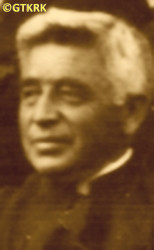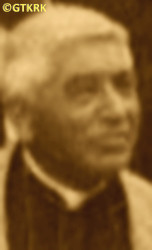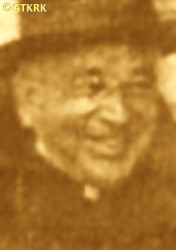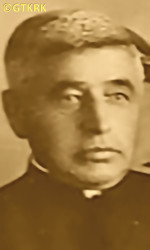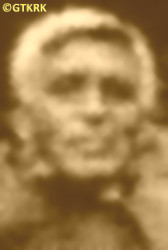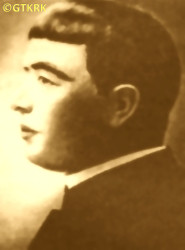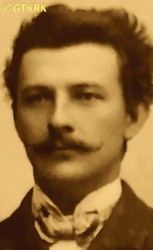Roman Catholic
St Sigismund parish
05-507 Słomczyn
85 Wiślana Str.
Konstancin deanery
Warsaw archdiocese, Poland
full list:
displayClick to display full list

searchClick to search full list by categories
wyświetlKliknij by wyświetlić pełną listę po polsku

szukajKliknij by przeszukać listę wg kategorii po polsku

Martyrology of the clergy — Poland
XX century (1914 – 1989)
personal data
surname
PRZYŁUSKI
forename(s)
Dominic (pl. Dominik)
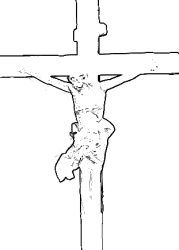
function
diocesan priest
creed
Latin (Roman Catholic) Church RCmore on
en.wikipedia.org
[access: 2014.09.21]
diocese / province
Lublin diocesemore on
pl.wikipedia.org
[access: 2013.05.19]
Mogilev archdiocesemore on
en.wikipedia.org
[access: 2013.06.23]
RC Military Ordinariate of Polandmore on
en.wikipedia.org
[access: 2014.12.20]
honorary titles
honorary canonmore on
honorary canon
(1938, Our Lord's Resurrection and St Thomas the Apostle RC collegiate church, Zamośćtoday: Zamość gm., Zamość pov., Lublin voiv., Poland
more on
en.wikipedia.org
[access: 2021.06.07])
Order of Saint Stanislav (Russian Empire) 3rd classmore on
Order of Saint Stanislav (Russian Empire) 3rd class
(c. 1907)
Order of St Anna (Imperial Russia) 3rd classmore on
Order of St Anna (Imperial Russia) 3rd class
(c. 1907)
date and place
of death
22.12.1942

Garbówtoday: Garbów gm., Lublin pov., Lublin voiv., Poland
more on
en.wikipedia.org
[access: 2021.08.20]
details of death
After the German and Russian invasion of Poland in 09.1939 and the beginning of World War II, after start of the German occupation, fainted during a German search in his rectory: was hiding Jews, who, however, were not detected by the Germans. Garbów is located c. 20 km from Lublin, where the Germans established the German „Wohngebiet der Juden” (Eng. „Jewish residential district”), i.e. ghetto, on 24.03.1941, as one of the first in the Germ. Generalgouvernement (Eng. General Governorate). After the German attack on 22.06.1941 on their erstwhile ally, the Russians, and the decision on the Germ. „Endlösung der Judenfrage” (Eng. „Final Solution of the Jewish Question”) — this phrase was used in the order of SS‐Gruppenführer Reinhard Heydrich from 07.1941 — on 17.03‐11.04.1942, the Germans deported about 30,000 Jews from the Lublin ghetto and murdered them in the German extermination camp VL Belzec. The last 4,000 were murdered by the Germans in KL Lublin. A small number of Jews escaped the ghetto and hid in Lublin and the surrounding area.
Several other Jews, caught that day in the village, were murdered by the Germans in front of the municipal building.
Could not bear it and perished — went to be with the Lord.
cause of death
heart attack
perpetrators
Germans
sites and events
VL BelzecClick to display the description, Help to the JewsClick to display the description, GeneralgouvernementClick to display the description, Ribbentrop‐MolotovClick to display the description, Pius XI's encyclicalsClick to display the description
date and place
of birth
05.10.1872

Buchałowicetoday: Kurów gm., Puławy pov., Lublin voiv., Poland
more on
en.wikipedia.org
[access: 2021.08.20]
alt. dates and places
of birth
06.10.1872
Motycz Leśnytoday: Konopnica gm., Lublin pov., Lublin voiv., Poland
more on
en.wikipedia.org
[access: 2021.08.20]
parents
PRZYŁUSKI Adalbert Joseph
🞲 1837, Drążgówtoday: Ułęż gm., Ryki pov., Lublin voiv., Poland
more on
en.wikipedia.org
[access: 2025.08.19] — 🕆 11.05.1881, Lublintoday: Lublin city pov., Lublin voiv., Poland
more on
en.wikipedia.org
[access: 2021.08.20]

OCHAL Marianne
🞲 01.02.1836, Kurówtoday: Kurów gm., Puławy pov., Lublin voiv., Poland
more on
en.wikipedia.org
[access: 2021.08.20] — 🕆 1914, Matczyntoday: Bełżyce gm., Lublin pov., Lublin voiv., Poland
more on
en.wikipedia.org
[access: 2021.09.29]
presbyter (holy orders)
ordination
03.07.1898

Lublintoday: Lublin city pov., Lublin voiv., Poland
more on
en.wikipedia.org
[access: 2021.08.20]
St John the Baptist and St John the Evangelist RC cathedral churchmore on
en.wikipedia.org
[access: 2025.03.14]
positions held
1920 – 1942
parish priest — Garbówtoday: Garbów gm., Lublin pov., Lublin voiv., Poland
more on
en.wikipedia.org
[access: 2021.08.20] ⋄ Transfiguration of the Lord RC parish ⋄ Kurów / Puławydeanery names/seats
today: Lublin voiv., Poland RC deanery
1911 – 1920
curatus/rector/expositus — Kumówtoday: Kumów Plebański, Leśniowice gm., Chełm pov., Lublin voiv., Poland
more on
en.wikipedia.org
[access: 2021.08.20] ⋄ Visitation of the Blessed Virgin Mary RC parish ⋄ Chełmtoday: Chełm city pov., Lublin voiv., Poland
more on
en.wikipedia.org
[access: 2021.08.20] RC deanery
1909 – 1911
vicar — Urzędówtoday: Urzędów gm., Kraśnik pov., Lublin voiv., Poland
more on
en.wikipedia.org
[access: 2021.08.20] ⋄ St Nicholas the Bishop and Confessor RC parish ⋄ Janów Lubelskiform.: Janów Ordynacki
today: Janów Lubelski gm., Janów Lubelski pov., Lublin voiv., Poland
more on
en.wikipedia.org
[access: 2021.08.20] RC deanery — delegated to the ministry in the St Bartholomew the Apostle parish in Niedrzwica, Lublin deanery
1909 – 1911
priest — Niedrzwicatoday: Niedrzwica Kościelna, Niedrzwica Duża gm., Lublin pov., Lublin voiv., Poland
more on
en.wikipedia.org
[access: 2021.08.20] ⋄ St Bartholomew the Apostle RC parish ⋄ Lublintoday: Lublin city pov., Lublin voiv., Poland
more on
en.wikipedia.org
[access: 2021.08.20] RC deanery — in fact acted as an administrator
1907 – 1909
vicar — Lublintoday: Lublin city pov., Lublin voiv., Poland
more on
en.wikipedia.org
[access: 2021.08.20] ⋄ St John the Baptist and St John the Evangelist RC cathedral parish ⋄ Lublintoday: Lublin city pov., Lublin voiv., Poland
more on
en.wikipedia.org
[access: 2021.08.20] RC deanery
1906 – 1907
vicar — Harbintoday: Heilongjiang prov., China
more on
en.wikipedia.org
[access: 2024.03.19] ⋄ St Stanislav the Bishop and Martyr RC parish (Polish)
1905 – 1906
RC military chaplain — 3rd Manchurian Army, Imperial Russian Army — among Polish soldiers
1900 – 1905
vicar — Lublintoday: Lublin city pov., Lublin voiv., Poland
more on
en.wikipedia.org
[access: 2021.08.20] ⋄ St Paul the Apostle RC parish ⋄ Lublintoday: Lublin city pov., Lublin voiv., Poland
more on
en.wikipedia.org
[access: 2021.08.20] RC deanery
1898 – 1900
vicar — Lublintoday: Lublin city pov., Lublin voiv., Poland
more on
en.wikipedia.org
[access: 2021.08.20] ⋄ St Stanislav the Bishop and Martyr RC church ⋄ St Paul the Apostle RC parish ⋄ Lublintoday: Lublin city pov., Lublin voiv., Poland
more on
en.wikipedia.org
[access: 2021.08.20] RC deanery — assistant to the rector
1893 – 1898
student — Lublintoday: Lublin city pov., Lublin voiv., Poland
more on
en.wikipedia.org
[access: 2021.08.20] ⋄ philosophy and theology, Theological Seminary
sites and events
descriptions
VL Belzec: German Germ. Vernichtungslager (Eng. extermination camp) VL — oficially known as SS‐Sonderkommando Belzec — operational from 03.1942 till 06.1943 n. Belzec village, c. 4 km to the south of Tomaszów Lubelski, founded as part of German „Reinhardt” program of extermination of Jewish population. Victims were mainly Polish Jews from ghettos and camps in German‐run General Governorate, mainly from Galicia, Cracow and Lublin districts; but also Austrian, Czech, German, Slovak and Hungarian Jews. The victims were murdered in stationary gas chambers with exhaust fumes. The number of exterminated is estimated to reach c. 450,000. The camp was run by c. 20. German and Austrian SS functionaries at any one time. They were supported by a company of watchmen (Germ. SS‐Wachmannschaften) — mainly former Russian POWs who switched sides, in general of Ukrainian nationality. (more on: en.wikipedia.orgClick to attempt to display webpage
[access: 2020.02.08])
Help to the Jews: During World War II on the Polish occupied territories Germans forbid to give any support to the Jews under penalty of death. Hundreds of Polish priests and religious helped the Jews despite this official sanction. Many of them were caught and murdered.
Generalgouvernement: After the Polish defeat in the 09.1939 campaign, which was the result of the Ribbentrop‐Molotov Pact and constituted the first stage of World War II, and the beginning of German occupation in part of Poland (in the other, eastern part of Poland, the Russian occupation began), the Germans divided the occupied Polish territory into five main regions. In two of them new German provinces were created, two other were incorporated into other provinces. However, the fifth part was treated separately, and in a political sense it was supposed to recreate the German idea from 1915 (during World War I, after the defeat of the Russians in the Battle of Gorlice in 05.1915) of creating a Polish enclave within Germany. Illegal in the sense of international law, i.e. Hague Convention, and public law, managed by the Germans according to separate laws — especially established for the Polish Germ. Untermenschen (Eng. subhumans) — till the Russian offensive in 1945 it constituted part of the Germ. Großdeutschland (Eng. Greater Germany). Till 31.07.1940 formally called Germ. Generalgouvernement für die besetzten polnischen Gebiete (Eng. General Government for the occupied Polish lands) — later simply Germ. Generalgouvernement (Eng. General Governorate), as in the years 1915‐1918. From 07.1941, i.e. after the German attack on 22.06.1941 against the erstwhile ally, the Russians, it also included the Galicia district, i.e. the Polish pre‐war south‐eastern voivodeships. A special criminal law was enacted and applied to Poles and Jews, allowing for the arbitrary administration of the death penalty regardless of the age of the „perpetrator”, and sanctioning the use of collective responsibility. After the end of the military conflict of the World War UU, the government of the Germ. Generalgouvernement was recognized as a criminal organization, and its leader, governor Hans Frank, guilty of war crimes and crimes against humanity and executed. (more on: en.wikipedia.orgClick to attempt to display webpage
[access: 2024.12.13])
Ribbentrop‐Molotov: Genocidal Russian‐German alliance pact between Russian leader Joseph Stalin and German leader Adolf Hitler signed on 23.08.1939 in Moscow by respective foreign ministers, Mr. Vyacheslav Molotov for Russia and Joachim von Ribbentrop for Germany. The pact sanctioned and was the direct cause of joint Russian and German invasion of Poland and the outbreak of the World War II in 09.1939. In a political sense, the pact was an attempt to restore the status quo ante before 1914, with one exception, namely the „commercial” exchange of the so‐called „Kingdom of Poland”, which in 1914 was part of the Russian Empire, fore Eastern Galicia (today's western Ukraine), in 1914 belonging to the Austro‐Hungarian Empire. Galicia, including Lviv, was to be taken over by the Russians, the „Kingdom of Poland” — under the name of the General Governorate — Germany. The resultant „war was one of the greatest calamities and dramas of humanity in history, for two atheistic and anti‐Christian ideologies — national and international socialism — rejected God and His fifth Decalogue commandment: Thou shall not kill!” (Abp Stanislav Gądecki, 01.09.2019). The decisions taken — backed up by the betrayal of the formal allies of Poland, France and Germany, which on 12.09.1939, at a joint conference in Abbeville, decided not to provide aid to attacked Poland and not to take military action against Germany (a clear breach of treaty obligations with Poland) — were on 28.09.1939 slightly altered and made more precise when a treaty on „German‐Russian boundaries and friendship” was agreed by the same murderous signatories. One of its findings was establishment of spheres of influence in Central and Eastern Europe and in consequence IV partition of Poland. In one of its secret annexes agreed, that: „the Signatories will not tolerate on its respective territories any Polish propaganda that affects the territory of the other Side. On their respective territories they will suppress all such propaganda and inform each other of the measures taken to accomplish it”. The agreements resulted in a series of meeting between two genocidal organization representing both sides — German Gestapo and Russian NKVD when coordination of efforts to exterminate Polish intelligentsia and Polish leading classes (in Germany called «Intelligenzaktion», in Russia took the form of Katyń massacres) where discussed. Resulted in deaths of hundreds of thousands of Polish intelligentsia, including thousands of priests presented here, and tens of millions of ordinary people,. The results of this Russian‐German pact lasted till 1989 and are still in evidence even today. (more on: en.wikipedia.orgClick to attempt to display webpage
[access: 2015.09.30])
Pius XI's encyclicals: Facing the creation of two totalitarian systems in Europe, which seemed to compete with each other, though there were more similarities than contradictions between them, Pope Pius XI issued in 03.1937 (within 5 days) two encyclicals. In the „Mit brennender Sorge” (Eng. „With Burning Concern”) published on 14.03.1938, condemned the national socialism prevailing in Germany. The Pope wrote: „Whoever, following the old Germanic‐pre‐Christian beliefs, puts various impersonal fate in the place of a personal God, denies the wisdom of God and Providence […], whoever exalts earthly values: race or nation, or state, or state system, representatives of state power or other fundamental values of human society, […] and makes them the highest standard of all values, including religious ones, and idolizes them, this one […] is far from true faith in God and from a worldview corresponding to such faith”. On 19.03.1937, published „Divini Redemptoris” (Eng. „Divine Redeemer”), in which criticized Russian communism, dialectical materialism and the class struggle theory. The Pope wrote: „Communism deprives man of freedom, and therefore the spiritual basis of all life norms. It deprives the human person of all his dignity and any moral support with which he could resist the onslaught of blind passions […] This is the new gospel that Bolshevik and godless communism preaches as a message of salvation and redemption of humanity”… Pius XI demanded that the established human law be subjected to the natural law of God , recommended the implementation of the ideal of a Christian state and society, and called on Catholics to resist. Two years later, National Socialist Germany and Communist Russia came together and started World War II. (more on: www.vatican.vaClick to attempt to display webpage
[access: 2023.05.28], www.vatican.vaClick to attempt to display webpage
[access: 2023.05.28])
sources
personal:
www.glaukopis.plClick to attempt to display webpage
[access: 2012.11.23], cdn02.sulimo.plClick to attempt to display webpage
[access: 2019.10.13], theo-logos.plClick to attempt to display webpage
[access: 2024.12.13], cdn02.sulimo.plClick to attempt to display webpage
[access: 2019.10.13], www.geni.comClick to attempt to display webpage
[access: 2021.12.19]
original images:
www.facebook.comClick to attempt to display webpage
[access: 2024.12.13], www.facebook.comClick to attempt to display webpage
[access: 2024.12.13], cdn02.sulimo.plClick to attempt to display webpage
[access: 2019.10.13], www.facebook.comClick to attempt to display webpage
[access: 2024.12.13], cdn02.sulimo.plClick to attempt to display webpage
[access: 2019.10.13], cdn02.sulimo.plClick to attempt to display webpage
[access: 2019.10.13], www.geni.comClick to attempt to display webpage
[access: 2021.12.19], www.facebook.comClick to attempt to display webpage
[access: 2024.12.13]
LETTER to CUSTODIAN/ADMINISTRATOR
If you have an Email client on your communicator/computer — such as Mozilla Thunderbird, Windows Mail or Microsoft Outlook, described at WikipediaPatrz:
en.wikipedia.org, among others — try the link below, please:
LETTER to CUSTODIAN/ADMINISTRATORClick and try to call your own Email client
If however you do not run such a client or the above link is not active please send an email to the Custodian/Administrator using your account — in your customary email/correspondence engine — at the following address:

giving the following as the subject:
MARTYROLOGY: PRZYŁUSKI Dominic
To return to the biography press below:
 Click to return to biography
Click to return to biography








